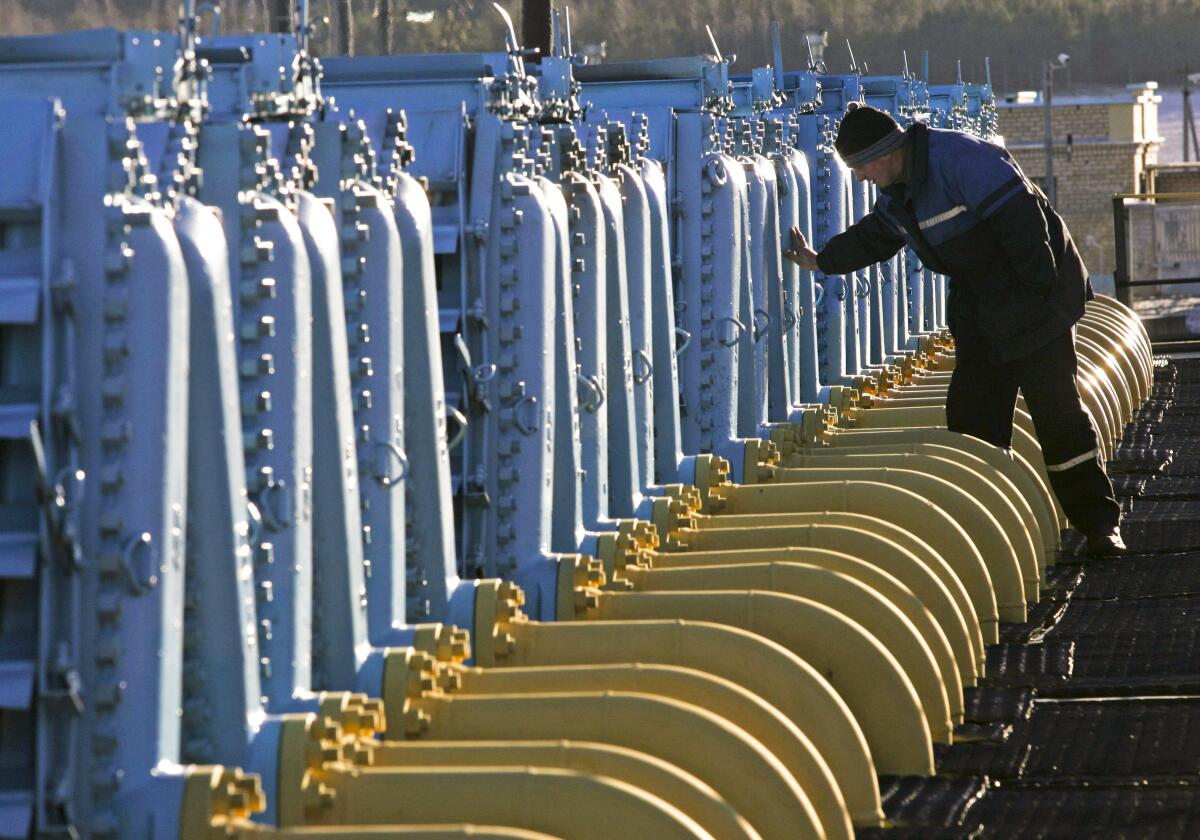Op-Ed: How heat pumps can help save Ukrainians from Putin and the rest of us from climate change

- Share via
Heat pumps aren’t usually considered war-fighting materiel, but these heating-and-cooling appliances could be almost as crucial to the defense of Ukraine as antitank and antiaircraft missiles.
Heat pumps are basically air conditioners that can also run in reverse; they can heat or cool a house. As heaters, they are three to four times more energy efficient than conventional furnaces (essentially because they move hot air around rather than generating it). And because they are powered by electricity, not fossil fuels, they offer a cost-effective path toward decarbonization. Commercial and residential buildings account for 13% of U.S. and 6% of global greenhouse gas emissions; eliminating heating and cooling emissions is an essential step toward tempering climate change’s accelerating ferocity.
At the beginning of the Ukraine war, author and climate activist Bill McKibben wrote a Substack column calling on the U.S. government to launch a massive program to manufacture millions of heat pumps and send them to Europe, as a way of countering both the European Union’s reliance on Russian fossil fuels and the global climate crisis. The Biden administration is reportedly seriously considering the idea, the International Energy Agency included it in a 10-point plan to reduce the EU’s Russian fuel consumption, and more than 200 U.S. environmental groups, along with five U.S. senators, endorsed it.
The idea makes sense because replacing gas furnaces and conventional air conditioners with heat pumps is a no-brainer. My family’s new home, now under construction in Vermont, will include three heat pumps — a large one for the main house and two smaller ones for an exterior studio and a residential unit above the garage — along with solar panels and strong insulation. Including installation, the three pumps will cost roughly $25,000 — about a third more than conventional heating — but we figure our energy bills will be so low that within about seven years the system will pay for itself, and air conditioning will be a bonus.
McKibben is calling on President Biden to invoke the Defense Production Act to spur U.S. manufacturers to make heat pumps, then provide them at or below cost to the European Union, just as the U.S. government provided food, fuel and weapons to Europeans under the pre-World War II Lend-Lease Act. Rewiring America, a pro-electrification nonprofit, soon added another element: Set in motion a Peace Corps-like program to train Americans in heat pump installation (which requires knowledgeable technicians) and send them to Europe to install the units there.
Summing up the potential impact of this plan is easy: win-win-win-win.
Win 1. Heat pumps would help end Europe’s indirect support for Vladimir Putin’s war machine. According to the International Energy Agency, in 2021 the EU relied on Russia for nearly 40% of its total natural gas consumption. From the beginning of the war until early April, the EU paid 35 billion euros into Putin’s coffers for energy and gave Ukraine 1 billion euros for its defense, according to Josep Borrell, the EU’s top diplomat.
The IEA estimates that a suite of decarbonization measures including heat pumps could result in a reduction of EU demand for Russian gas by more than a third within a year, with lasting emissions benefits for generations.
Win 2. The U.S. economy would benefit. Given enough incentives, manufacturers of climate-unfriendly gas boilers and air conditioners could easily transition to making heat pumps, according to Leah Stokes, a UC Santa Barbara decarbonization expert. (It doesn’t hurt the plan’s political attractiveness that many of these manufacturers are based in swing states.) And installers who are trained and sent to Europe could, when they return, jump-start the process here too.
Win 3. As heat pumps proliferate, Americans’ health would improve correspondingly. Unvented gas heaters and gas stoves emit harmful pollutants including nitrogen dioxide, a toxic gas that even in low concentrations increases the risk of respiratory infections, particularly in young children. A 2013 meta-analysis of 41 international studies found that children in homes with gas stoves have a 42% increased risk of asthma. A 2020 essay in the New England Journal of Medicine advocated a ban on sales of new gas appliances and new residential and commercial gas hookups.
Win 4. Finally, soaring heat pump production and sales here could mean that the U.S. is finally getting serious about combating climate change’s dire threat. While it’s true that in the next few years some of the electricity to power heat pumps would come from fossil fuels — about 40% of California’s electricity, for example, still comes from nonrenewable sources — concerted decarbonization campaigns would hasten a shift to renewable sources such as wind and solar. Part of that effort includes banning or discouraging gas hookups in new buildings (more than 50 California cities or counties have already enacted such policies) and incentivizing the installation of heat pumps that could begin reducing greenhouse gas emissions immediately.
The Ukraine war and the climate crisis are inextricably intertwined: The oil and gas industry, which generated 60% of Russia’s export earnings before sanctions, finances its war machine and also fuels the climate crisis. Let President Biden know: A national push for heat pumps offers the U.S. a welcome chance to take righteous action on a scale big enough to reduce both threats at once.
Jacques Leslie is a contributing writer to Opinion.
More to Read
A cure for the common opinion
Get thought-provoking perspectives with our weekly newsletter.
You may occasionally receive promotional content from the Los Angeles Times.










